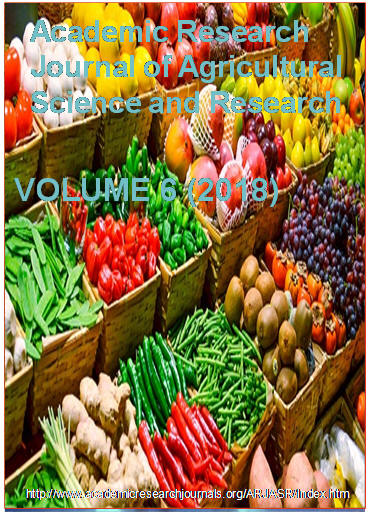| ARJASR |
Academic Research Journal of
Agricultural Science and Research |
|||||||||||||||||||
|
Vol. 6(8), pp. 495-499. October, 2018. ISSN: 2360-7874 DOI: 10.14662/ARJASRD2018.081 Full Length Research Adaptation and Improvement of Wheat and Rice Harvester for Small and Mid-level Farmers of Ethiopia
1Yonas Lemma (MSc), 2Abiy Solomon (MSc)
1Associate Researcher, Agricultural Machinery Engineering 2Associate Researcher, Agricultural Engineering Research, Ethiopian Institute of Agricultural Research
Accepted 29 October 2018
During harvesting season, often rain and storm cause considerable damage to standing crops. Rapid harvest facilitates extra days for land preparation and earlier planting of the next crop. Thus the use of harvesting machines can help to harvest at proper stage of crop maturity and reduce drudgery and operation time, which also generates spare time for education, social, cultural and political activities and human development especially for women headed household’s farmers. So that these type of harvesting machines are crucial to solve the harvesting problems of small and mid-level of farmers. Thus considering the advantage of small and mid-level harvesting machines, this experiment were planned to evaluate the performance of the machines. The experiments were conducted at Ginir and Kulumssa on wheat crop variety name kakaba and digelu and Fogera on Rice crop variety name x-jegena. Three treatments were selected for the performance evaluations were walking behind harvester, brush cutter harvester and manual with sickle. The results indicate that walking behind harvester has 0.23±0.03ha/hr field capacity while brush cutter harvester and manual harvesting using sickle have field capacity 0.035±0.04ha/hr and 0.013±0.07ha/hr respectively on wheat crop. Labour(man-hr per ha) result which include the time taken to harvest the crop and to collect the harvested crop in to one place/ to make a hip of the harvested crop therefore the two machine i.e. using walking behind harvester and brush cutter have taken 7.6 and 29 hr/ha respectively, while, manual harvesting method using sickle has taken 82 hr/ha. The loss of grain for the three treatments were non-significant at 14.02 %( wb) moisture content (mc) of the wheat, it is around 3%. But the mc of the crop drops the total machines losses became much higher beyond the recommendation. It also found that the variety of the crops matters the total machine loss and the overall performance of the harvesters. Generally the performances of the three treatments were lower on rice crop (table-3) than wheat (table-1, and 2).
Key Word: Rice, wheat, vertical reaper harvester, brush cutter and manual harvesting with sickle
How to cite this article (APA Style): Lemma, Y., Solomon, A. (2018). Adaptation and Improvement of Wheat and Rice Harvester for Small and Mid-level Farmers of Ethiopia. Acad. Res. J. Agri. Sci. Res. 6(8): 495-499
|
|||||||||||||||||||
